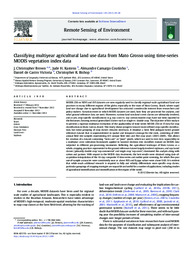Classifying multiyear agricultural land use data from Mato Grosso using time-series MODIS vegetation index data.
Classifying multiyear agricultural land use data from Mato Grosso using time-series MODIS vegetation index data.
Author(s): BROWN, J. C.; KASTENS, J. H.; COUTINHO, A. C.; VICTORIA, D. de C.; BISHOP, C. R.
Summary: MODIS 250-m NDVI and EVI datasets are now regularly used to classify regional-scale agricultural land-use practices in many different regions of the globe, especially in the state of Mato Grosso, Brazil, where rapid land-use change due to agricultural development has attracted considerable interest from researchers and policy makers. Variation exists in which MODIS datasets are used, how they are processed for analysis, and what ground reference data are used. Moreover, various and-use/land-cover classes are ultimately resolved, and as yet, crop-specific classifications (e.g. soy?corn vs. soy?cotton double crop) have not been reported in the literature, favoring instead generalized classes such as single vs. double crop. The objective of this study is to present a rigorous multiyear evaluation of the applicability of time-series MODIS 250-m VI data for crop classification in Mato Grosso, Brazil. This study shows progress toward more refined crop-specific classification, but some grouping of crop classes remains necessary. It employs a farm field polygon-based ground reference dataset that is unprecedented in spatial and temporal coverage for the state, consisting of 2003 annual field site samples representing 415 unique field sites and five crop years (2005-2009). This allows for creation of a dataset containing "best-case" or "pure" pixels, which we used to test class separability in a multiyear cross validation framework applied to boosted decision tree classifiers trained on MODIS data subjected to different pre-processing treatments. Reflecting the agricultural landscape of Mato Grosso as a whole, cropping practices represented in the ground reference dataset largely involved soybeans, and soy-based classes (primarily double crop "soy-commercial" and single crop "soy-cover") dominated the analysis along with cotton and pasture. With respect to the MODIS data treatments, the best results were obtained using date-ofacquisition interpolation of the 16-day composite VI time series and outlier point screening, for which five-year out-of-sample accuracies were consistently near or above 80% and Kappa values were above 0.60. It is evident that while much additional research is required to fully and reliably differentiate more specific crop classes, particular groupings of cropping strategies are separable and useful for a number of applications, including studies of agricultural intensification and extensification in this region of the world.
Publication year: 2013
Types of publication: Journal article
Unit: Embrapa Territorial
Observation
Some of Embrapa's publications are published as ePub files. To read them, use or download one of the following free software options to your computer or mobile device. Android: Google Play Books; IOS: iBooks; Windows and Linux: Calibre.
Access other publications
Access the Agricultural Research Database (BDPA) to consult Embrapa's full library collection and records.
Visit Embrapa Bookstore to purchase books and other publications sold by Embrapa.

